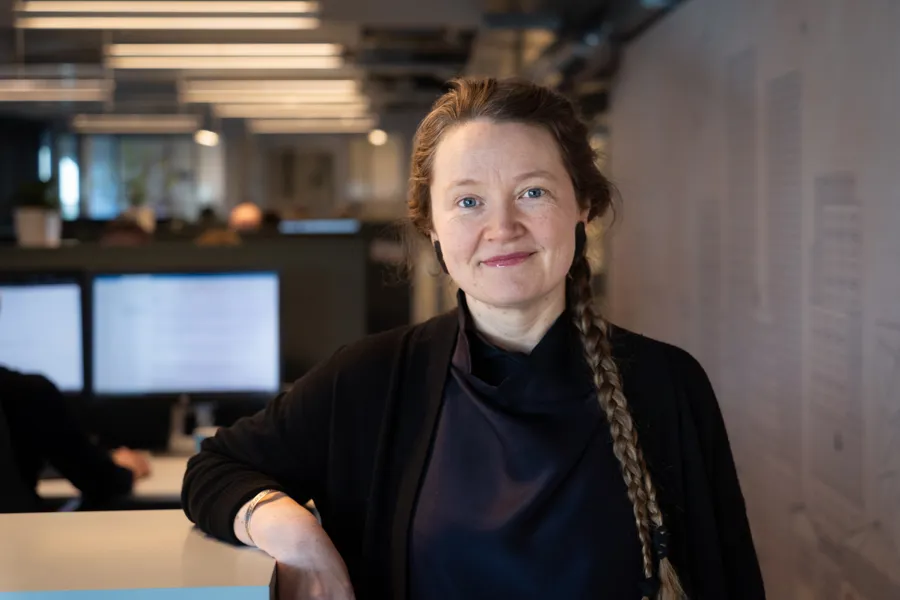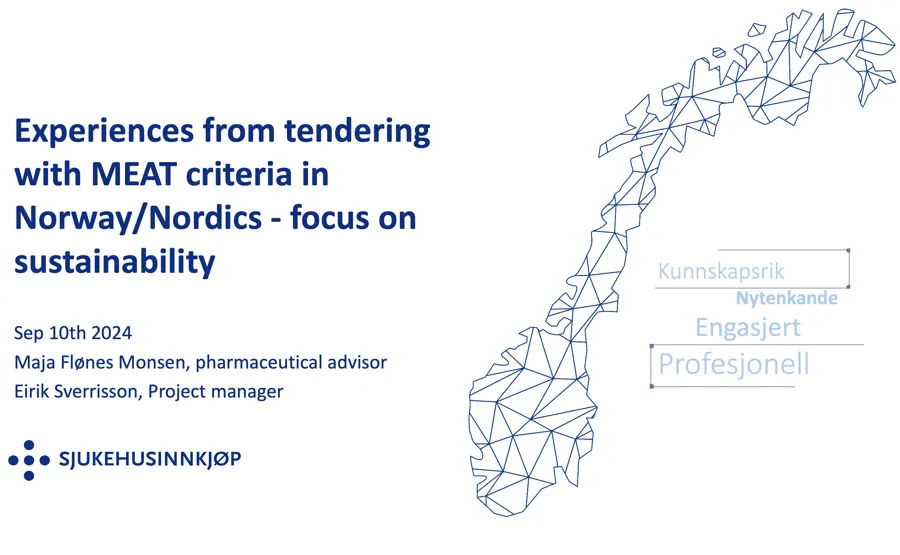Norge jobber for felles internasjonale miljøkrav i anskaffelse av legemidler
Legemiddelindustrien etterlyser mer samkjørte miljøkriterier for legemiddelanskaffelser rundt om i Europa. Norge jobber for en internasjonal standard for miljøkrav.

Sykehusinnkjøps arbeid med krav på dette feltet er oppsummert i den ferske erfaringsrapporten «Miljøkrav i legemiddelanskaffelser 2022-2023».
English version here
Norway wants international enviromental standard for procurement of pharmaceuticals
The pharmaceutical industry is calling for more coordinated environmental criteria for pharmaceutical procurement around Europe. Norway is working towards an international standard for environmental requirements.
Sykehusinnkjøp HF (Norwegian Hospital Procurement Trust) is managing this work on behalf of the Norwegian government.
Our recent work in this field is summarized in the recent experience report "Environmental requirements in pharmaceutical procurement 2022-2023" (Download pdf here).
This is the second bi-annual edition of this report. A major new topic this time is the emerging international cooperation, especially in the area of antibiotics.
Norway works with environmental requirements through participation in the Nordic Pharmaceutical Forum. In addition, Sykehusinnkjøp is working together with the AMR Industry Alliance and the British Standards Institution (BSI) on certification schemes.
Goodwill from the industry
Currently, no other country has introduced as strict environmental requirements for drug procurement as Norway.
However, the foundation for a broader international cooperation in this area exists, says Maja Flønes Monsen in Sykehusinnkjøp's medicines division. She has authored the the new report on environmental requirements.
Sykehusinnkjøp's experience from the most recent years of pharmaceutical procurements also shows that the suppliers are willing to change. During the work on the report, two big international dialogue meetings were held with representatives of the industry.
– One of our main tasks is to help the purchasing organizations in other countries to adopt a common framework for environmental criteria. This is also something that the industry is calling for. They do not want to repeat this work in a different way in every country where they try to make business, says Monsen.
She works as a purchasing adviser, and has particular responsibility for procurement of pharmaceuticals where criteria other than price are used.
Little extra work and no price leap
A total of around 15 large procurements of pharmaceuticals where the new environmental requirements have been included have been carried out in Norway. In addition, there is currently an ongoing procurement with such requirements in the common Nordic cooperation with Denmark.
Among the conclusions in the experience report is that evaluation of environmental requirements does not entail any significant extra work per precurement for Sykehusinnkjøp.
Nor have the requirements resulted in price increases for the medicines.
– For instance, in one of the completed procurements, we ended up with price decreases, reducing our costs with NOK 90 million per year compared to the previous contract. But it may be that the decrease would have been slightly greater without the environmental criteria included, says Monsen.
Antibiotics is a frontrunner
Antibiotics is a priority group for the introduction of the environmental requirements. In this area, part of the strategy is to ensure that prices stay above a certain threshold, not force it further down.
This is because rapidly declining prices globally has forced several companies to close their production due to lack of profit. Sykehusinnkjøp is working with the Nordic Pharmaceutical Forum (NLF) to keep prices high enough to secure a steady supply of antibiotics for the future.
Sykehusinkjøp has worked by the theory that if we do it right for antibiotics, it will be easier to include other drug groups later. This has turned out to be correct.
– Our new report shows that it is actually possible to use environmental criteria on a large scale, says Maja Flønes Monsen.
Emissions, shipping and recycling
In the tendering process, potential suppliers are required to give details on the origin of the active ingredient in the drug, as well as where and how the finished product is manufactured.
In total, more than 20 environmental criteria have been introduced, which gives Sykehusinnkjøp the opportunity to more thoroughly map the production chain of the medicines we get delivered in Norway.
The criteria also include elements such as:
- System for environmental management in production, certified by a third party
- Reduction of water consumption and emissions in production
- Aim for zero emissions in transport, as well as the lowest possible transport volume (avoid unnecessary weight or packaging with a lot of air)
- Environmentally friendly packaging materials, preferably suitable for recycling
- No greenhouse gases used as additives in the product
Other countries on the fence
In the report, Sykehusinnkjøp concludes that there is strong interest from other countries in introducing and further developing environmental requirements in the pharmaceutical area. In practice, however, the big steps have not yet been taken, and Norway hopes to be lead the way in this field.
– It will be easier for other countries to do the same when Norway and Denmark have cleared the trail first, says Monsen.
Denmark is one of the countries that has come a long way in the work. In 2024, there will also be several joint Nordic procurements with new environmental requirements, via the Nordic cooperation.
The UK and the Netherlands are also heading in the right direction.
Hopes for certification
In a couple of years, Sykehusinnkjøp will publish a new issue of this report. By then, it's author, Maja Flønes Monsen, hopes that the environmental requirements Norway has introduced so far, are holding up well, and can be made stricter.
The report underlines that both large and small producers must be given time to adapt to the new requirements. Because of this, it is important to maintain a good dialogue with the industry, and introduce more comprehensive requirements at a reasonable pace.
– We also hope to be able to set requirements for the phasing out of environmentally harmful substances. In addition, there is a need for independent certification of the environmental impact of the entire production system for pharmaceuticals, says Maja Flønes Monsen.
During a supplier conference organized by Sykehusinnkjøp in Oslo this month, the British BSI will participate, and speak about the collaboration with Norway on this kind of certification.
Det er andre gang en slik rapport utarbeides, og nytt i denne perioden er et gryende internasjonalt samarbeid, spesielt på antibiotika-området.
Norge jobber blant annet med miljøkrav gjennom deltakelsen i Nordisk legemiddelforum (NLF). I tillegg kommer dialog og samarbeid med den nye sertifiseringsordningen til AMR Industry Alliance og British Standards Institution (BSI).
Leverandørene er velvillige
Foreløpig har ingen andre land innført så strenge miljøkrav til legemiddel-anskaffelser som Norge. Men forutsetningene er der, er rapportforfatter Maja Flønes Monsen i Sykehusinnkjøps divisjon legemidler tydelig på.
Dessuten er leverandørene også endringsvillige, viser erfaringen Sykehusinnkjøp har gjort under anskaffelsene de siste årene. Under arbeidet med rapporten er det også gjennomført to internasjonale dialogmøter med representanter for industrien.
– En av hovedoppgavene våre er å hjelpe innkjøpsorganisasjonene i flere land til å ta i bruk de samme miljøkriteriene. Det er også noe industrien etterlyser, slik at de ikke må gjøre dette arbeidet på ulik måte for hvert land de skal inn i anbudskonkurranse med, forteller Monsen.
Hun jobber som innkjøpsrådgiver og har spesielt ansvar for anskaffelser av legemidler med kriterier utover pris.
- Last ned rapporten her: Erfaringsrapport Miljø 2023.pdf
- English version of the report: Environmental Requirements for Pharmaceutical Procurements 2022-2023.pdf

Lite merarbeid – ingen prishopp
Det er totalt gjennomført rundt 15 store anskaffelser av legemidler med miljøkrav i Norge. I tillegg er det nylig publisert en anskaffelse med oppdaterte miljøkrav i det fellesnordiske samarbeidet med Danmark og Island.
Blant konklusjonene i erfaringsrapporten er at evaluering av miljøkrav ikke medfører noe vesentlig ekstraarbeid for Sykehusinnkjøp.
Kravene har heller ikke medført noen prisøkning på legemidlene.
– I en av de gjennomførte anskaffelsene har vi eksempelvis endt med en besparelse på 90 millioner kroner per år sammenlignet med forrige treårsperiode. Men det kan være at nedgangen ville vært litt større uten miljøkriteriene, sier Monsen.
Antibiotika i front
Antibiotika-legemidler brukes som foregangsgruppe for innføring av miljøkravene. Og her er det også nettopp en del av strategien å sørge for at prisene ikke går for langt ned. Da er det nemlig fare for at flere produsenter legger ned produksjonen, og det går utover konkurransen og forsyningssikkerheten.
Nylig lanserte Sykehusinnkjøp, via arbeidet i Nordisk Legemiddelforum (NLF), en strategi som jobber for et prisgulv for antibiotika.
Sykehusinnkjøps teori da arbeidet med miljøkrav startet, var at får man det til på antibiotika-området, vil det være lettere å overføre det til andre legemiddelgrupper. Og dette har vist seg å holde vann.
– Denne rapporten viser at det faktisk er mulig i stor skala å stille slike krav, sier Maja Flønes Monsen.
Utslipp, frakt og resirkulering
I innkjøpsprosessen kan potensielle leverandører opplyse blant annet opprinnelsesland og -produsent for virkestoffet, samt hvor det ferdige produktet blir produsert.
Til sammen er det innført over 20 miljøkriterier som gir Sykehusinnkjøp mulighet for å kartlegge mer av kretsløpet til legemiddelet vi får levert i Norge.
Dette innbefatter også momenter som:
- System for miljøledelse i produksjonen, sertifisert av en tredjepart
- Reduksjon av vannforbruk og utslipp i produksjonen
- Mål om nullutslipp i transport, samt lavest mulig transportvolum (unngå unødvendig høy vekt eller forpakninger med mye luft)
- Miljøvennlig emballasje, helst egnet for resirkulering
- Ikke drivhusgass som tilsetningsstoff i produktet.
Andre land på gjerdet
I rapporten konkluderer Sykehusinnkjøp med at det er sterk interesse fra andre land for å innføre og videreutvikle miljøkrav på legemiddelområdet. I praksis er det imidlertid ikke tatt de store skrittene ennå, og Norge håper å kunne lede an i arbeidet.
– Det blir lettere for andre land å gjøre det samme når Norge og Danmark har gått opp løypa først, sier Monsen.
Danmark er et av landene som har kommet et godt stykke på vei i arbeidet. I 2024 følger også flere fellesnordiske anskaffelser med nye miljøkrav, via Nordisk legemiddelforum (NLF). Storbritannia og Nederland er også på vei i riktig retning.
Håper på sertifisering
Sykehusinnkjøps erfaringsrapport på dette området skal utgis i ny utgave om et par års tid. Da håper rapportforfatteren at miljøkravene Norge har innført til nå, står seg godt og kan strammes ytterligere til.
I rapporten poengteres det at både de store og de små produsentene må få tid til å omstille seg til de nye kravene. Da er det viktig med en åpen dialog med bransjen, og en gradvis innstramming av kravene i fornuftig takt.
– Vi håper også på mer handlingsrom til å stille krav til utfasing av miljøskadelige stoffer. Og i tillegg at det brer om seg med uavhengig sertifisering av miljøpåvirkningen for hele produksjonssystemet for legemidler, sier Maja Flønes Monsen.
Under et leverandørseminar i regi av Sykehusinnkjøp i Oslo 14. mars deltar blant annet britiske BSI for å snakke om samarbeidet med Norge om en slik sertifisering.